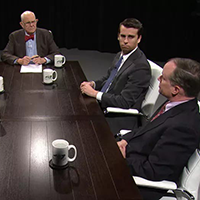Vaccinations could reduce preventable deaths
Published December 3, 2013
by Thomas Goldsmith, News and Observer, December 3, 2013.
Amira Welch says she converted from being reluctant about having her children vaccinated to becoming a champion for the practice when her husband, Lee, contracted a kidney disease.
The Welches, of Raleigh, visited a Duke clinic the day before Thanksgiving for a checkup for Lee, 49, that included a flu shot. His immune system is suppressed as he awaits a transplant, and that means that he, Amira, 36, and their four children need to be ultra-cautious about infectious disease.
“Now I’m an advocate for inocculation,” said Amira, who is studying for a master’s degree in health care administration at UNC-Chapel Hill.
Not only did the Welches want to avoid Lee’s getting a disease that he could transmit to his children, ages 7 through 11, she said, but the children also needed to get vaccinated, to remain healthy so they wouldn’t pass infections to him.
The family’s decision comes as national and state health officials push to increase vaccination rates among adults, a shift they say could greatly reduce the 50,000 deaths from preventable disease that occur in the United States every year.
Among the diseases from which many millions of people remain unprotected: influenza, pneumococcal infections and shingles. Most recent state figures show that about 45 percent of adults in North Carolina receive the influenza vaccine, lower than in neighboring South Carolina and Virginia. North Carolina’s rate would have to double to reach the 90 percent rate public health officials have set as a target for 2020.
Several factors are driving the effort, including a task force called the National Adult Vaccine Program, according to experts in North Carolina and at the recent Gerontological Society of America conference in New Orleans. Among them:
• Growing realization among public and private health leaders of the cost of preventable disease, estimated at $87 billion a year for influenza nationally.
• Increasing ability to have the cost of vaccines covered by health insurance, partly as a result of the federal health law.
• Use of electronic medical records to allow doctors and other providers access to accurate records of patients’ vaccination status.
“We’re pretty good at keeping people up to speed with vaccinations until their mid-teenage years,” said Dr. Cameron Wolfe, a Duke University Medical Center expert on infectious disease. “Then guys avoid the doctor like the plague.”
Lee Welch conceded that he had failed to keep up with his shots before he contracted kidney disease.
“It’s a guy thing,” he said.
Women generally tend to stay more involved with their health care than do men, Wolfe said. And figures from the federal Centers for Disease Control and Prevention show that women 18-49 are 20 percent more likely to receive flu vaccinations than men of that age group.
Protection for everyone
In North Carolina, as in other regions of the country, skepticism about benefits and perceived dangers of vaccinations have led in some cases to lower vaccination rates and even disease outbreaks. In April, the CDC assisted in controlling a measles outbreak in Western North Carolina that originated with a traveler who had been in India. It led to the exposure of more than 1,000 people.
“During April and May, direct and indirect transmission from the returning traveler resulted in 22 identified cases of measles (including the two cases first reported), for a total of 23 cases overall,” a federal report said. “Most cases were among residents of a largely unvaccinated religious community in rural North Carolina.”
The North Carolina Department of Health and Human Services is emphasizing the importance of vaccines at every stage of life and encouraging residents to talk to their doctors about which vaccines are appropriate given ages and health factors, said Julie Henry, assistant director of communications for DHHS.
As in the Welches’ case, there are many situations in which people must consider not only their own health, but also the presence in the community of those who cannot be vaccinated for various reasons, public health officials said.
“Vaccines protect the immunized, but they also protect the community,” Dr. William Schaffner, chairman of the Department of Preventive Medicine at Vanderbilt University, said at the Gerontological Society of America conference.
Said Henry: “People have a right to make a choice, but they do need to think about what precautions they need to take to protect others if they take that chance.”
Levels of controversy have surrounded vaccinations since at least 1998, when a single, since-retracted study in the United Kingdom proposed a link between childhood vaccines and autism.
“It has so well proven not to be the case,” Wolfe said. “It really set vaccination back a long way. It directly led to a lot of deaths.”
Some religious and libertarian groups have questioned the role in vaccine promotion of large pharmaceutical corporations, several of which have contributed to the National Adult Vaccine Program.
In any case, Duke University Medical Center, UNC Hospitals and most other hospitals follow the CDC guideline that requires flu vaccines for all employees except in narrow exceptions.
“We want to be vertical during the influenza outbreak, not horizontal,” Schaffner said.
Requiring vaccinations of the staff at a nursing home or hospital not only protects them, but also helps prevent the infection of residents or patients with suppressed immune systems, Wolfe said.
Ask the doctor
From state physicians interviewed to the National Adult Vaccine Program leaders, people involved in the effort stress the importance of patients asking questions and making decisions about vaccinations.
“For adults there are obstacles we don’t see in children – children have regular checkups,” said Dr. Daniel Gilstrap, the physician and medical instructor who saw Lee Welch on Wednesday. “We’re surprised every year at the number of otherwise healthy people who die of influenza.”
A growing number of people are being vaccinated against the pneumococcal diseases specifically caused by strep bacteria.
“In general, it’s recommended for the immunocompromised, but after 65 every adult should get it,” Gilstrap said.
The vaccine against the painful, debilitating disease shingles will likely see greater use under the federal Affordable Care Act, public health officials said. Previously, its price – from about $150 to as much as $300 with costs of administering it – kept usage down.
“Clearly that’s been an obstacle to everyone’s getting that vaccine,” Gilstrap said.
Several factors – lack of accurate information, inadequate access to health care in general, distrust of “Big Pharma” and the expense for some vaccines – have suppressed vaccination rates, public health officials said. But increased use of electronic medical records and changes in insurance reimbursement may help move the needle in the other direction, said Wolfe, the Duke infectious disease expert.
“The list of vaccines for adults has expanded quite a lot in the last few years,” he said. “Not only that, the knowledge of the safety of these vaccines has increased.”
It’s important to get information out because younger generations have grown up without encountering disease such as polio or measles, Wolfe said.
“We’ve done so well with them, people forget how bad these diseases can be,” he said.







